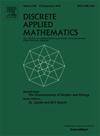A biased edge coloring game
IF 1
3区 数学
Q3 MATHEMATICS, APPLIED
引用次数: 0
Abstract
We combine the ideas of edge coloring games and asymmetric graph coloring games and define the -edge coloring game, which is alternatively played by two players Maker and Breaker on a finite simple graph with a set of colors . Maker plays first and colors uncolored edges on each turn. Breaker colors only one uncolored edge on each turn. They make sure that adjacent edges get distinct colors. Maker wins if eventually every edge is colored; Breaker wins if at some point, the player who is playing cannot color any edge. We define the -game chromatic index of to be the smallest nonnegative integer such that Maker has a winning strategy with . We give some general upper bounds on the -game chromatic indices of trees, determine the exact -game chromatic indices of some caterpillars and all wheels, and show that larger does not necessarily give us smaller -game chromatic index.
求助全文
约1分钟内获得全文
求助全文
来源期刊

Discrete Applied Mathematics
数学-应用数学
CiteScore
2.30
自引率
9.10%
发文量
422
审稿时长
4.5 months
期刊介绍:
The aim of Discrete Applied Mathematics is to bring together research papers in different areas of algorithmic and applicable discrete mathematics as well as applications of combinatorial mathematics to informatics and various areas of science and technology. Contributions presented to the journal can be research papers, short notes, surveys, and possibly research problems. The "Communications" section will be devoted to the fastest possible publication of recent research results that are checked and recommended for publication by a member of the Editorial Board. The journal will also publish a limited number of book announcements as well as proceedings of conferences. These proceedings will be fully refereed and adhere to the normal standards of the journal.
Potential authors are advised to view the journal and the open calls-for-papers of special issues before submitting their manuscripts. Only high-quality, original work that is within the scope of the journal or the targeted special issue will be considered.
 求助内容:
求助内容: 应助结果提醒方式:
应助结果提醒方式:


